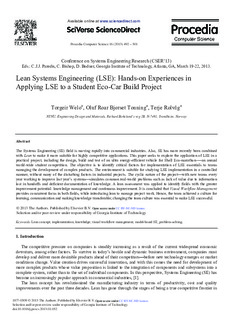| dc.contributor.author | Welo, Torgeir | |
| dc.contributor.author | Tonning, Oluf Roar Bjørset | |
| dc.contributor.author | Rølvåg, Terje | |
| dc.date.accessioned | 2018-02-23T08:27:58Z | |
| dc.date.available | 2018-02-23T08:27:58Z | |
| dc.date.created | 2013-06-17T09:47:21Z | |
| dc.date.issued | 2013 | |
| dc.identifier.citation | Procedia Computer Science. 2013, 16 492-501. | nb_NO |
| dc.identifier.issn | 1877-0509 | |
| dc.identifier.uri | http://hdl.handle.net/11250/2486619 | |
| dc.description.abstract | The Systems Engineering (SE) field is moving rapidly into commercial industries. Also, SE has more recently been combined with Lean to make it more suitable for highly competitive applications. This paper seeks to explore the application of LSE in a practical project, including the design, build and test of an ultra energy-efficient vehicle for Shell Eco-marathon–—an annual world-wide student competition. The objective is to identify critical factors for implementation of LSE essentials to teams managing the development of complex products. The environment is suitable for studying LSE implementation in a controlled manner, without many of the disturbing factors in industrial projects. The cyclic nature of the project—with new teams every year working to improve last year's systems—simulates common real-world problems such as lack of value due to information lost in handoffs and deficient documentation of knowledge. A lean assessment was applied to identify fields with the greater improvement potential: knowledge management and continuous improvement. It is concluded that Visual Workflow Management provides concurrent focus in both fields, while introducing lean to manage project work. Hence, the team achieved a culture for learning, communication and making knowledge transferable; changing the team culture was essential to make LSE successful. | nb_NO |
| dc.language.iso | eng | nb_NO |
| dc.publisher | Elsevier | nb_NO |
| dc.rights | Attribution-NonCommercial-NoDerivatives 4.0 Internasjonal | * |
| dc.rights.uri | http://creativecommons.org/licenses/by-nc-nd/4.0/deed.no | * |
| dc.title | Lean Systems Engineering (LSE): Hands-on Experiences in Applying LSE to a Student Eco-Car Build Project | nb_NO |
| dc.type | Journal article | nb_NO |
| dc.type | Peer reviewed | nb_NO |
| dc.description.version | publishedVersion | nb_NO |
| dc.source.pagenumber | 492-501 | nb_NO |
| dc.source.volume | 16 | nb_NO |
| dc.source.journal | Procedia Computer Science | nb_NO |
| dc.identifier.doi | 10.1016/j.procs.2013.01.052 | |
| dc.identifier.cristin | 1034552 | |
| dc.relation.project | Norges forskningsråd: 174838 | nb_NO |
| dc.relation.project | Norges forskningsråd: 210862 | nb_NO |
| dc.description.localcode | Copyright © 2013 The Authors. Published by Elsevier B.V under a CC BY-NC-ND 3.0 license. | nb_NO |
| cristin.unitcode | 194,64,92,0 | |
| cristin.unitname | Institutt for maskinteknikk og produksjon | |
| cristin.ispublished | true | |
| cristin.fulltext | original | |
| cristin.qualitycode | 1 | |

